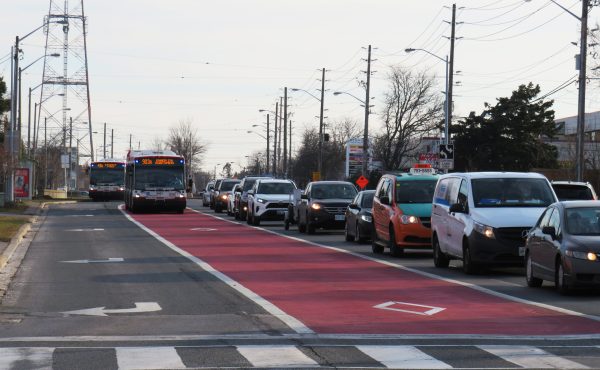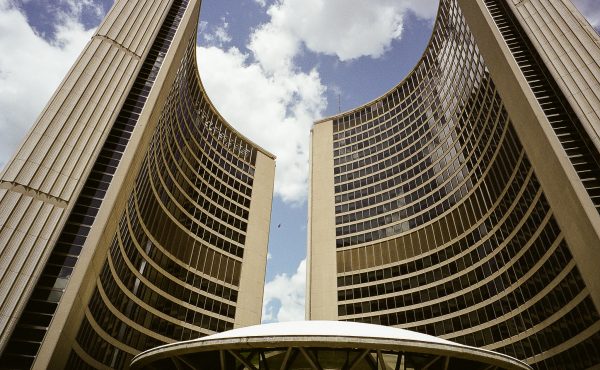
While Christmas is a long way off, Mayor Rob Ford decided to dangle a shiny bauble in front the eyes of North York and Scarborough voters, pledging during his radio campaign commercial, uh, show, that privatizing garbage collection east of Yonge will be on his to-do list for the 2014 election.
This obvious diversion tactic must be considered in the light of a pair of new polls that offer some key insights into the changing complexion of voter attitudes towards the city’s most vexing problem, which, it must be said, is not garbage.
Last week, Stratcom (whose principals worked on George Smitherman’s mayoral campaign) released a poll showing that Ford’s approval ratings fell sharply in both Scarborough and North York since February. In North York, his numbers plunged from 56 to 40%, while Scarborough’s approval rating dropped from 48 to 41%. Just over a third of Toronto respondents overall felt he is doing a good job — a figure that nudges up against David Miller’s all-time low of 29%, during the garbage strike. (Stratcom’s poll of 954 voters is accurate within 3.2%, 19 times out of 20.)
Voters in those parts of the city, it would be reasonable to surmise, may be growing weary of Ford’s empty and undeliverable transit promises. Indeed, according to a new Environics survey of GTA residents, Ford looks to be on the wrong side of one of the region’s most top-o’-mind concerns: transportation.
The Focus GTA poll results, which Environics generously agreed to share with Spacing Toronto readers, reveal that the number of respondents who cited transportation as the GTA’s single most pressing issue jumped sharply, from 22% to 38% between last fall and this spring. Six in ten found commuting to be stressful or very stressful, although that figure is somewhat smaller (52%) within the 416. (Environics’ results are based on 1,436 responses to an online survey.)
The stressed-out commuter story isn’t new or surprising. But the Focus GTA survey also begins to add texture to the picture of how chronic gridlock — and the associated lack of investment in transit — affects health, commerce and travel habits.
For example, the poll showed that a growing number of Torontonians feel they are spending too much time commuting to maintain a healthy lifestyle. And almost 40% have changed their shopping patterns specifically to avoid traffic (a result that doesn’t necessarily favour downtown retailers).
Others still are altering their commuting habits, with a fifth of Toronto respondents choosing to walk or ride to work more frequently. Environics also found that 18% are driving less frequently because of traffic headaches.
These numbers strongly suggest that driver irritation is beginning to lead to demonstrable changes in travel behaviour — a crucial finding that builds on other well-documented trends, such as ever increasing rush-hour crowds on the Yonge-University-Spadina subway line due to boardings at north-end stations. What’s more, the growth in condo starts, and the associated decline in housing starts, suggest that more people who move to Greater Toronto are willing to locate in more urbanized areas rather than in car-dependent subdivisions built on the periphery.
To my eye, these results indicate pent-up demand for better transit in those parts of the city-region that aren’t well served by the same.
The political architecture of the question of how to deliver more and better transit is well known: Metrolinx is investing heavily in LRTs (Toronto), BRTs (Mississauga and York Region) and an expansion of GO, while the TTC’s Spadina extension up to Vaughan is well underway. But tens of billions in new transit infrastructure is needed to accommodate future GTA population growth, and the province has yet to signal how it plans to raise the cash.
In April, Spacing reported that 74% of Environics respondents supported an Los Angeles-style regional sales tax to fund transit and road improvements. In the Focus GTA survey, Environics asked its respondents to rank various funding tools. In Toronto, 41% supported a parking tax, while 31% of all GTA residents backed a vehicle registration tax (that’s the levy that Ford jettisoned immediately upon taking office). While those numbers are still a long way from majority territory, fully 71% approved of one or more funding tools.
According to Environics analyst Darren Karasiuk, these numbers indicate a clear change in public opinion compared to last year, when most respondents said they felt governments had enough money and didn’t much care for new levies or taxes. But the March transit showdown between the Fords and the Stintz 26 was a gamechanger in every way, resulting in a discernible shift in public attitudes towards earmarked taxes (including tolls) for transit investment. “We’ve grown up as a city,” says Karasiuk. “Many cities have road pricing system in place. World class cities cost something to build. They don’t come free.”
What the Stratcom and Environics polls say to me is that a growing number of voters across the GTA are waking up from the magical-thinking politics of 2010 and 2011, and have begun to realize that the Ford solution is no solution at all.
Postscript: Speaking of congestion, news reports over the weekend of massive crowding at the Toronto ferry docks raises, yet again, a question I’ve posed previously in this space: why isn’t there a fixed pedestrian link to the Toronto Islands? The ferry service is an antiquated municipal monopoly that impedes access to one of the city’s pre-eminent public spaces.
Yes, the views from the ship are gorgeous. But if connectivity is the sine qua non of urban living, why can’t we come up with other ways to get to the island? A fixed link over the eastern gap? Or, perhaps, an extension to the passageway now being built to Toronto Billy Bishop Airport that would allow cyclists and pedestrians to safely reach the western end of the island? After all, we are paying for that tunnel.
Just asking…





17 comments
An Eastern Gap bridge would take a massive load off Union Station Streetcar platform in the summer months. I think the problem is that the Ford administration isn’t too amenable to bridges “only” for pedestrians as we saw with Fort York. As was pointed out over the weekend the City will depend even more on the Islands now that Ontario Place is shut.
The problem with a link at the Eastern Gap is that it would be (a) miles from downtown and (b) deposit you at Wards. For the Western Gap, aside from dodging the planes, you would first need to get to the foot of Bathurst Street (try doing that when there’s any event on at the CNE) and then make your way from Hanlans to Centre. Mind you, attendance at the nude beach might go up.
People want to go to Centre Island because that’s where the attractions are. The idea of a fixed link at either end of the archipelago ranks with some of the Fords’ transit planning for demand analysis.
Doubling the airport tunnel for general access to island would work. To get it beyond the airport property would certainly be very tricky. It could either mean a lot more digging (and at least double or triple the cost), or finding a surface route around the runway (does not seem quite feasible). That said, a link via airport may be better than the east gap in terms of location. It is closer to downtown core and much better served by transit. An east gap link will put too many tourists near the village on the island which will certainly affect that little gem in a very big way. But I won’t hold my breath for anything to happen anyway. The city and the airport do not see eye to eye to each other. I would have a hard time imagining the two collaborate on such a project.
@Steve,
Do we know the full extent of demand for the island, or has demand been shaped by the limitations of the existing transportation service? I feel confident that there are lots of Torontonians (myself included) who would like to go to the island more frequently, but avoid it because the only way to get there is so fraught with crowding and delay on both legs of the journey.
Also, I’d add that with portlands revitalization at least theoretically on the city’s planning horizon, a connection at the eastern end would mesh well with other public space and circulation plans for the Portlands. And let’s hope we never get into the mindset of only putting pedestrian and cycling routes in places where we know that traffic already exists… It’s not at all analogous to the build-it-and-they-will-come disease that afflicts politicized transit planning.
I don’t see the problem with a bridge over the Eastern Gap being farther from downtown or being at Ward’s Island. Maybe being close to downtown is not necessarily ideal for traffic patterns, and where landing at Ward’s is concerned, it’s not as if the island is too big for you to make it to other points on the island within a short time.
I don’t agree with the comment that the Eastern Gap is ‘miles’ from anywhere — Centre Island nor downtown. Islanders, yacht owners, and folks wanting to eat lunch at the Rectory would all take a bike (particularly with a Bixi/bike rental installation at Cherry Beach) over the Eastern Gap in preference to the ferry. And, it would make the Islands a de facto part of the ‘Lake Ontario Park’ concept. Love the idea.
I think it’s fair to say that an eastern gap crossing is problematic in the context of the islands’ status as a regional attraction. Poor transit accessibility on the mainland side (and thus pressure to build a lot of parking on the mainland). Distance from the central attractions (roughly 2 to 3 km to the main beach, Centreville etc.) Good connectivity to residential communities, but again poor connections on the mainland side.
(A question: when the Centre Island ferry is overloaded and passengers need to wait for the second or third ferry, to what extent do people currently choose to use the Ward’s Island ferry and then walk west?)
And don’t discount the intangible that the ferry provides — it adds to the islands feeling like a “getaway” from the city by representing a transition. I don’t think you get that same impression from a footbridge — especially one that is inconveniently located. Instead of the romance of crossing on the ferry, you have a 30-minute trudge from a parking lot in (for now) industrial wasteland.
I don’t believe the issue is the ferry. The issue is having insufficient capacity on the ferry, and resulting crowds. Wouldn’t it be simpler to buy another ferry to put in service on summer weekends? Right now ferries run every half hour, improved to 15 minutes when conditions warrant. (News reports said that they were only running every half hour this weekend, which would have been a problem.) With an extra ferry, the service could probably run such that there was always a ferry docked loading or unloading passengers, or within a short distance of the docks (the maritime equivalent of the old TTC “always a car in sight”). That would go a long way to addressing crowds and patience of passengers.
Ferries should be run by TTC as in Boston and Vancouver. Wouldn’t solve capacity issues but might make fare payment flow better once on Presto, etc.
Regardless, an alternate should be provided for many reasons and the ped tunnel to the airport is the perfect solution. Need to find some way to skirt the airport and tunnel under the runway but it could definitely be done.
As a long-time Islander, I feel compelled to jump in here. Others have noted the issues regarding an eastern or western gap bridge (although no one has expressed concern that the former could serve as a stealth mechanism for vehicular access–a deeply unappealing outcome).
However, I believe that the manner in which the ferry service is run is worth investigation. For example, were all the ticket booths staffed this past weekend? And if they were, the system of access–handing off tickets to only two ticket takers–slows things down. Then there’s the matter of the schedule, which was still on spring frequency–every half hour to Centre rather than every 15 minutes. The more-frequent summer schedule goes into effect later this week. Why was it not implemented *before* the long weekend?
A similar problem has arisen for at least the past two Easter weekends. Great weather, predicted well ahead, but the spring schedule (which means service to Centre on a big ferry, rather than Ward’s only on the small-capacity Ongiara) only came into effect a week later. There have been huge lines, even violence, as a result.
The ferry office seems to operate as its own fiefdom, with little apparent oversight. One theory: there’s a class issue here, since the majority of Island visitors aren’t of Important or monied, and hence are less likely to complain about the often-shoddy manner in which the service is run.
Lynn> In the massive line on Sunday that zig and zagged out and down Queens Quay, when we realized they weren’t running the summer schedule, a few of us got upset. It wasn’t just the crowds, that’s fine, it’s the management of the operation.
calling it a ‘class issue’ is a bit of a stretch. More likely is the fact that the ferry runs on pre-defined schedules and a little patch of good weather is not a reason for them to change to a more frequent service. We also had two glorious weeks of sun and heat in March, yet the ferry stayed on its spring schedule, because it was still spring.
Should it change its schedule to include the May long weekend as the real kick-off to the summer schedule? Perhaps, though I reckon throughout history we’ve had more frigid Victoria days than hot. Should they constantly change the schedule depending on what the weather for the week looks like? No.
I think it is weird to have to pay to go to a public park. The ferry is great and all, but there should be a free option.
The City of Toronto, The Toronto Port Authority and The Billy Bishop Airport management all have said no to working together to extend the pedestrian tunnel passageway under the Billy Bishop Airport runways to Hanlans Point.
The City of Toronto is working together with the Toronto Port Authority and the Billy Bishop Airport to create a tunnel under the island airport runways to bury new waste water and fresh water pipes for the Toronto Works Department, which has a $20 million dollar budget to replace the existing, deteriorated infrastructure.
How many Torontonians know these facts?
All business, no Vision.
Frank> The 1000s and 1000s of people trying to get on the ferry would disagree with you. Do you work for the City?
By all means, the fact that the ferry was not yet on the summer schedule, or even a special schedule for the holiday weekend, shows an appallingly poor management. While this could be laid at the feet of Ford and his budget cuts, it’s not a problem brand new to his era. I went over to Wards on Saturday and just managed to squeeze onto the hourly sailing of the Ongiara.
The way that the payment and ticket taking is staffed is rather strange, but even more annoying is the physical facility. Decades ago, the city gave away space for a good-sized ferry terminal to aid the developers of nearby land. The result was that the “experience” of waiting for the ferry is to be shoehorned into a left over channel between surrounding buildings. The story of how we got such a crappy terminal is an important part of looking at the effect of past political dynamics in Toronto on what we inherited today.
Finally, a connection from Cherry Beach to Wards Island would be good for cyclists, but should not be seen as a replacement for better service on the ferry. It will be a very long time before we see good transit all the way down to the south end of Cherry (even the “old” plan for the port lands does not take the LRT line that far south), and the now-and-then Pape bus views with the ferry service for infrequency.
Let’s concentrate on fixing the ferry service.
Is the eastern gap used for shipping at all? That could complicate things by imposing a height restriction on the bridge.
The minimum clearance for a bridge over such a waterway would have to be at least 60 feet to accommodate the masts on sailboats. OTOH, boats could just go around if necessary. It’s probably not the best idea to have a pedestrian link at the cost of a passage for boats.
How much would a ~250m bridge 60′ above the water cost? It could be much more expensive than the bridge that’s being built over the train tracks west of Bathurst, which is only about half as long.
Council should have a study done if it hasn’t been done already.
An Eastern Gap bridge would probably be openable.